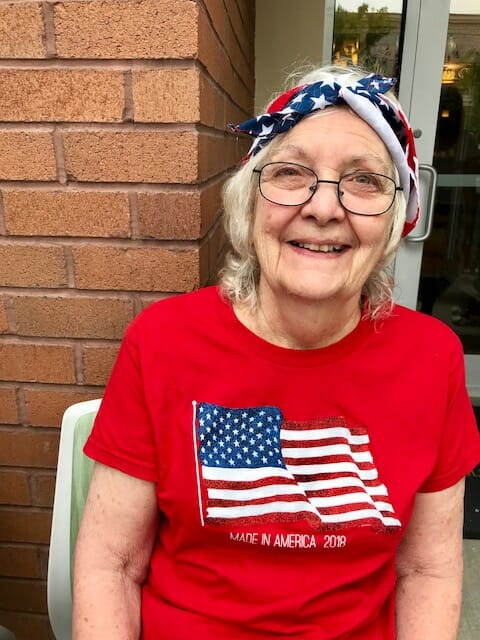You may have heard that not all assisted living facilities offer the same level of care. It’s true.
Depending on the support and resources available, levels of care may differ. The question is: how do you know which level of care — and facility — is best for you and your loved ones?
We get that understanding the types of care in an assisted facility isn’t always easy. Seniors and family members of seniors: your care is our top priority.
Whether you’re ready to move today or are considering assisted living in the future, it’s important to have a strong understanding of your options.
When it comes to learning more about the levels of care provided in an assisted living facility, we’re here to simplify the process. In this article, we’ll dive into what to expect at each of the three levels of care in assisted living facilities.
Level up your understanding of assisted living care with Village Walk’s complete guide to the levels of care in assisted living.
Key article takeaways
- The three levels of care range from minimal assistance to complete assistance with one or more activities of daily living (ADLs)
- Enhanced assisted living is for seniors who want a mix of independent and assisted living.
- More help may be needed if an individual struggles with Alzheimer’s or dementia.
- Assisted living staff create a needs-based assessment and care plan to determine the support needed for prospective residents.
- The cost of assisted living increases as the need for caregivers increases. Residents can check with their facility at any time to reassess their care needs.
What to know about assisted living levels of care?
At its core, assisted living levels are determined by how much help a person needs with activities of daily living (ADLs). Common ADLs include bathing, grooming, using the restroom, dressing, transferring from a bed to a chair, medication management, and more.
Every assisted living facility defines levels of care with ADLS in a different way. Some facilities use five levels, and others use three.
What’s important to note is that as levels increase, the amount of attention and care does as well. At Village Walk, our assisted living facility divides care into three different levels.
The three levels of care explained
In our assisted living facility, the levels of care goes as follows:
- Level 1: minimal help and care needed
- Level 2: moderate hands-on care for an activity of daily living needed
- Level 3: Ongoing help with more than one daily living activity needed
Level 1: minimal help and care needed
Residents receiving level one assisted living care require little support for daily living. For example, a resident receiving level one care may need a short wake-up call in the morning and reminders to take their medication throughout the day.
Residents in this category often don’t need much supervision as they complete ADLs. But if a resident needs more help, they can ask to move into higher levels of care.
The next level up is level two, where residents receive moderate hands-on care.
Level 2: moderate hands-on care for ADLs
In level two, residents continue to show a level of independence. Seniors in level two often can feed themselves, but they may need help with other ADLs.
Residents in level two often need help with ADLs like dressing, grooming, and medication management. Balancing a senior’s need for hands-on support and desire for independence is what level two is all about.
Level 3: Ongoing assistance with daily living
At this level, seniors struggle to do most ADLs without assistance and supervision. Here at Village Walk, level three means more than one caregiver is present.
In level three, older adults often need help completing most tasks of daily life. Caregivers complete most ADLs for residents.
Some assisted living facilities offer extra help beyond level three. In these facilities, many caregivers, frequent assessments, and round-the-clock care are provided to residents.
At Village Walk, we offer memory care for those who need extra support beyond level three.
A few words on enhanced assisted living care
“But wait, where does enhanced assisted living care fit in?” you might be wondering.
We’d be doing you an injustice if we didn’t explain enhanced assisted living care to you. “Enhanced assisted living” is a more supportive version of independent living for older adults.
In other communities, enhanced assisted living may refer to assisted living as a catch-all for care that’s a step below memory care. Adults in enhanced assisted living facilities may receive all the same services and support as an assisted living facility, but residents may also receive skilled nursing and more involved medical care.
Residents receiving enhanced assisted living are often strong candidates for assisted living or memory care. Whether adding extra companion care or a skilled nurse, enhanced assisted living has many different meanings depending on the facility.
When extra care is needed
Generally, the best way to help decide whether a senior could use extra care is by looking at ADLs and caregivers. The more hands-on help and personal care that’s needed, the more likely seniors will need a higher level of care.
Village Walk checks in with families often to determine whether a senior’s care plan is right for them. Our assisted living residents always have different levels of care available to them.
Those needing a higher level of care need only speak with one of our qualified staff members to receive the appropriate level of care for their needs.
A breakdown of the levels of care in assisted living
| Level | Type of Care |
| Level 1 | 1. Minimal help and care needed 2. Little to no supervision is needed to complete activities of daily living |
| Level 2 | 1. A mix of hands-on help and supervision provided 2. Some help and hands-on care needed with at least 1 activity of daily living |
| Level 3 | 1. Ongoing support and supervision needed 2. Seniors need help with 2 or more activities of daily living and supervision |
| Memory Care | 1. Provides ongoing support and supervision as needed 2. Specialized staff help residents with Alzheimer’s disease, dementia, and other cognitive health needs |
How assisted living facilities assess the care needed
Whether your loved one needs intensive care or minimal support, assisted living facilities conduct a series of tests to determine how much support to provide.
The most common ways to determine which of the various levels of care is best for a senior is with the following:
- A needs-based assessment, and
- A senior care plan
A needs-based assessment
Before solidifying the services and care for a resident, senior living communities conduct a needs-based assessment.
In partnership with healthcare professionals, assisted living staff conduct this assessment to determine the right level of care needed to meet a senior’s needs.
Most assessments involve testing for physical and cognitive health, including:
- A resident’s mobility
- Gross and fine motor skills
- Medical conditions
- Depression
- And more
The needs-based assessment is conducted wherever is most convenient for the senior and their family. For example, a healthcare professional could assess the health of a senior in the senior’s home, in a clinical setting, or during a tour of the assisted living community.
The test is usually scored on a scale of one to five, with one meaning independence and five denoting dependence on a caregiver.
Generally, the assessment is conducted on a specific timeline and before a resident moves into a facility. Residential care facilities’ goal is to better understand a senior’s needs to have everything prepared for a senior come move-in day.
Creating a senior care plan
After testing a senior’s steadiness and agility, scoring their assessment, and determining which ADLs they can do, the facility creates a care plan. The staff and healthcare team then create a comprehensive care plan to determine the type of care the senior needs.
At the end of the day, the goal is to allow seniors to preserve their health and independence every step of the way. The level of care received determines the cost of care.
Did you know?
Worried about what to expect with the physical and cognitive skills assessment? There’s nothing to worry about with this process, but it can be helpful to know what to expect. Click here to learn more.
The cost of assisted living levels of care
Simply put: the more care, the higher the cost.
At most assisted living facilities, communities will charge a base fee for assisted living care. Seniors and their loved ones can also opt for care packages or an a la carte add-on list of services.
In this way, seniors and their loved ones can pay for only what they need. The largest factors affecting the cost of care include how many caregivers to hire to support the well-being and health of a resident.
At Village Walk, families have flexibility when it comes to the pricing of their care. Residents can choose from studio apartments, one-bedroom apartments, and two-bedroom club suites for all their care needs.
If at any point residents need more hands-on assistance, our staff can pivot to better meet residents’ needs.
Inspect care levels with an assisted living professional
Though the staff at our facility provides comprehensive information about our services, we always recommend seniors and their loved ones do their homework.
Between needs-based assessments, senior care plans, and general information about the three levels of assisted living care, information still gets lost in translation. As the market and options available for senior living continue to grow, you’ll want to do your research.
Inspect the levels of assisted living care early and often. Before deciding on which type of help is best for you or your loved one, do your research.
If research sounds daunting, the senior living advisors at Village Walk are happy to help.
They’d be more than willing to help explain the varying levels of care offered in an assisted facility. At the end of the day, we want you and your loved ones to thrive.
Don’t hesitate to reach out to one of our senior living concierge staff at any point to discuss the pros and cons of assisted living. We’re here to help!
Frequently Asked Questions (FAQ) About Assisted Living Care Levels
Who works in assisted living facilities at each care level?
Many home health aides and nurses are on-site in an assisted living facility. 24/7 skilled nursing may only be available at memory care facilities. For this reason, many assisted living communities have very specific criteria a resident must meet to be eligible for assisted living.
Facilities have many different types of staff available. For example, Village Walk hires senior living advisors, life enrichment coordinators, therapy aides, culinary chefs, and other healthcare professionals to meet the diverse needs of our residents.
When’s the best time to change care plans?
Many assisted facilities assess a resident’s needs at various intervals. Changes to care plans can be made on a quarterly, bi-annual, or annual basis.
But these aren’t the only times changes can be made. Assisted living staff members also can make changes if a family or community caregiver notices significant changes in behavior.
Assisted living staff join in shared activities to decide if changes are needed. In a word, changes are assessed at regular intervals, but can also be made as needed.
What happens when the care needed exceeds the assisted living facility’s capacities?
Depending on the level of care offered by a facility, many facilities can provide skilled care. For example, at Village Walk, we offer memory care for residents with Alzheimer’s disease or dementia in a separate wing of our facility.
Many assisted living and skilled nursing facilities can accommodate ever-evolving health concerns. Each assisted living facility has different eligibility requirements. We recommend reaching out to your desired assisted living facility to see which care is best for you or your loved one.
“Nothing short of exceptional care.”
“My experience with Village Walk at Patchogue has been nothing short of exceptional. From the moment you walk in, you can feel the warm and inviting atmosphere that permeates the building. The staff at Village Walk are not just professionals but are like an extended family.
In a world where finding excellent care for our loved ones can be a daunting task, Village Walk at Patchogue stands out as a beacon of excellence.” – Stephanie F., Happy Village Walk family member








